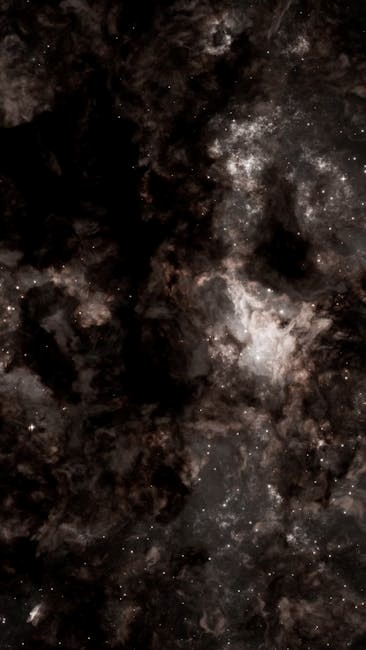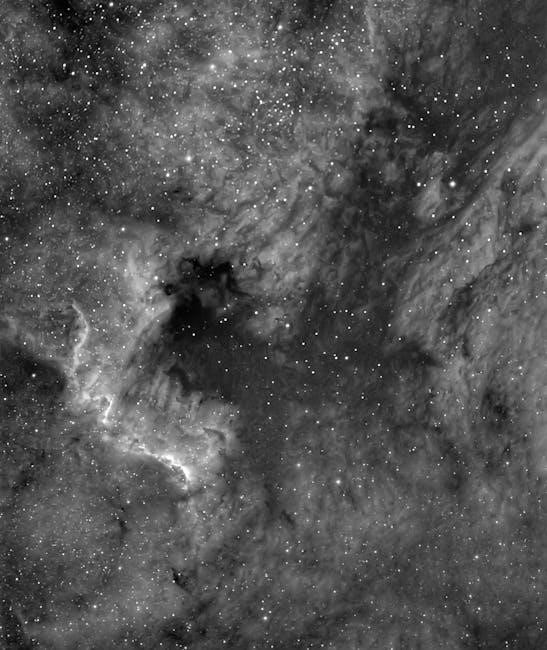Dark matter is a mysterious, invisible component making up most of the universe’s mass, influencing cosmic structures through gravity without emitting light․

1․1 What is Dark Matter?
Dark matter is an invisible form of matter that does not emit, absorb, or reflect light, making it undetectable through conventional astronomical observations․ It is inferred by its gravitational effects on visible matter, radiation, and the large-scale structure of the universe․ Comprising approximately 85% of the universe’s total matter, dark matter’s presence is vital for explaining phenomena like galaxy rotation curves and the formation of cosmic structures․ Despite its elusive nature, dark matter does not interact with electromagnetic forces, setting it apart from ordinary matter․ Its existence is indirectly confirmed through observations of gravitational lensing, galaxy clusters, and the cosmic microwave background radiation․
1․2 Why is Dark Matter Important?
Dark matter is crucial for understanding the universe’s structure and evolution․ It provides the gravitational scaffolding for galaxies and galaxy clusters to form and maintain their shape․ Without dark matter, the observed cosmic structures would not exist, as visible matter alone cannot account for the required mass․ Dark matter’s presence explains phenomena like galaxy rotation curves and the distribution of mass in galaxy clusters․ It also plays a key role in the universe’s expansion history and the formation of the cosmic web․ Studying dark matter helps uncover the fundamental laws of physics, potentially leading to discoveries of new particles or forces beyond the Standard Model of particle physics․
History of Dark Matter Research
Dark matter research began with early observations of gravitational effects in the 20th century, evolving through theoretical advancements and technological breakthroughs, shaping modern astrophysics and cosmology․
2․1 Early Observations of Dark Matter
The concept of dark matter emerged in the 1930s when Swiss astrophysicist Fritz Zwicky observed unexpected mass-to-light ratios in galaxy clusters․ His work suggested that most mass was invisible․ Earlier, in the 19th century, astronomers like Lord Kelvin noted discrepancies in galaxy rotation, hinting at unseen mass․ These early observations laid the foundation for modern dark matter theories, though they were not widely accepted at the time․ The idea gained traction in the 1970s with Vera Rubin and Kent Ford’s studies of galaxy rotation curves, confirming that visible matter alone could not explain gravitational effects․ These pioneering efforts reshaped our understanding of the universe’s structure and composition․
2․2 Key Milestones in Dark Matter Discovery
The discovery of dark matter has been marked by several pivotal moments․ In the 1970s, Vera Rubin and Kent Ford confirmed dark matter’s existence through galaxy rotation curves․ The 1980s saw the rise of the Cold Dark Matter (CDM) model, which became the standard cosmological framework․ The 1990s brought the “dark matter revolution,” with observations from the Cosmic Background Explorer (COBE) satellite supporting its role in cosmic structure formation․ In the 2000s, simulations like the Millennium Run refined dark matter models, while discoveries of “dark matter-dominated” galaxies further validated its presence․ Recent advancements include gravitational lensing mapping dark matter distributions and ongoing experiments like LUX-ZEPLIN aiming to detect dark matter particles directly․

Properties of Dark Matter
Dark matter is an invisible, non-luminous form of matter that interacts primarily through gravity, comprising approximately 27% of the universe’s total mass-energy density․
3․1 Mass and Gravity
Dark matter’s mass contributes significantly to the universe’s mass-energy density, making up approximately 27% of the total․ Its gravitational influence shapes galaxy rotations and cosmic structures, despite being invisible․ Unlike ordinary matter, dark matter does not emit or reflect light, yet its mass generates gravitational fields detectable through their effects on visible matter and light bending․ The mass of dark matter particles is inferred to be much greater than neutrinos but far less than black holes․ Gravity is the primary interaction driving dark matter’s role in cosmic dynamics, enabling it to dominate the formation and evolution of galaxies and galaxy clusters without interacting electromagnetically or through the strong nuclear force․
3․2 Dark Matter and Normal Matter Interaction
Dark matter interacts minimally with normal matter, primarily through gravity and possibly the weak nuclear force․ Unlike ordinary matter, it does not emit, absorb, or reflect light, making it invisible․ Its interaction with normal matter is so weak that it can pass through ordinary matter without significant influence․ However, gravitational interactions dominate, allowing dark matter to shape cosmic structures and influence galaxy dynamics․ While dark matter does not interact electromagnetically, its gravitational effects on visible matter provide indirect evidence of its presence․ Rare interactions, such as through the weak force, are hypothesized but remain undetected․ This limited interaction makes dark matter elusive yet fundamental to the universe’s structure․
3․3 Dark Matter and Light Interaction
Dark matter does not emit, absorb, or reflect light, making it invisible to telescopes․ Its interaction with light is negligible, as it lacks electromagnetic charge․ This property explains why dark matter remains undetected through direct optical observations․ However, its presence is inferred indirectly through gravitational effects, such as the bending of light (gravitational lensing) caused by its mass․ This phenomenon allows scientists to map dark matter distributions in galaxy clusters․ The absence of light interaction makes dark matter elusive but also highlights its unique role in shaping cosmic structures without participating in electromagnetic processes․ This characteristic distinguishes it from ordinary matter, which interacts freely with light․

Detection Methods for Dark Matter
Detecting dark matter involves indirect and direct methods, such as observing annihilation products or using underground detectors to sense particle interactions, requiring highly sensitive instruments․
4․1 Indirect Detection Methods
Indirect detection methods seek to identify dark matter by observing its annihilation or decay products, such as gamma rays, neutrinos, or cosmic rays․ These particles are emitted when dark matter particles collide and annihilate in regions like the galactic center or dwarf galaxies․ Observatories like the Fermi Gamma-Ray Telescope and the Alpha Magnetic Spectrometer (AMS) on the ISS are used to detect these signals․ By analyzing the energy spectra and spatial distribution of these particles, scientists aim to identify signatures unique to dark matter․ This approach relies on theoretical models predicting interaction rates and particle emissions, making it a complementary strategy to direct detection efforts․
4․2 Direct Detection Methods
Direct detection methods aim to observe dark matter particles interacting with normal matter in highly sensitive detectors․ These experiments typically use underground facilities to minimize cosmic ray interference․ Detectors are designed to register the faint signals produced when dark matter particles, such as WIMPs (Weakly Interacting Massive Particles), collide with atomic nuclei․ The expected signals include nuclear recoils, which are detected through scintillation, ionization, or phonon production․ Experiments like LUX-ZEPLIN and XENON1T use liquids or crystals as the target material․ Despite decades of effort, no confirmed detection has been made, but these experiments continue to constrain dark matter properties․ The rarity of interactions and the need for ultra-low background noise make direct detection extremely challenging but potentially groundbreaking․
4․3 Observational Evidence of Dark Matter
The existence of dark matter is supported by various observational evidence from the universe․ Galaxy rotation curves show stars orbiting at consistent speeds, implying unseen mass․ The cosmic microwave background (CMB) data reveals density fluctuations consistent with dark matter’s gravitational influence․ Gravitational lensing observes massive objects bending light, indicating dark matter’s presence․ Additionally, the distribution of galaxies in clusters and the formation of large-scale structures require dark matter to explain their stability and evolution․ While dark matter hasn’t been directly detected, these indirect observations provide strong evidence for its existence, shaping our understanding of the universe’s dynamics and composition․

Theories and Models of Dark Matter
Various theories propose dark matter’s nature, including Cold Dark Matter (CDM), Warm Dark Matter (WDM), and Self-Interacting Dark Matter, with axions and sterile neutrinos as candidates․
5․1 Cold Dark Matter (CDM)
Cold Dark Matter (CDM) is a widely accepted model where dark matter consists of slow-moving, heavy particles that interact weakly with normal matter․ CDM provides a framework for understanding the large-scale structure of the universe, as its properties allow for the formation of dense regions that seed galaxies․ The slow motion of CDM particles enables the clumping necessary for cosmic structures to emerge․ This model aligns with observations of the cosmic microwave background and galaxy distributions․ However, despite its success, the exact particle nature of CDM remains unknown, and challenges like the “cusp-core problem” in galaxy simulations persist․
5․2 Warm Dark Matter (WDM)
Warm Dark Matter (WDM) proposes that dark matter consists of lighter, faster-moving particles compared to Cold Dark Matter (CDM)․ These particles, with masses around keV-scale, interact more weakly and have higher velocities, suppressing the formation of small-scale structures․ WDM aims to address issues like the “missing satellite problem” and the “cusp-core problem” in galaxies, where CDM predictions differ from observations․ However, WDM struggles to explain the formation of the first stars and galaxies, as its higher thermal velocities inhibit early structure formation․ Observational constraints, such as the Lyman-alpha forest data, suggest a lower mass limit for WDM particles, making it less favored than CDM in standard cosmological models․
5․3 Self-Interacting Dark Matter
Self-Interacting Dark Matter (SIDM) posits that dark matter particles interact with each other through forces beyond gravity, potentially resolving discrepancies in galaxy observations․ Unlike collisionless Cold Dark Matter (CDM), SIDM allows particles to scatter, transferring energy and momentum․ This interaction smooths dense centers of galaxies, addressing the “cusp-core problem” where CDM predicts steep density profiles but observations show flatter cores․ SIDM also offers insights into galaxy cluster dynamics, such as the Bullet Cluster, where dark matter behavior aligns with interacting particles․ However, SIDM requires additional mechanisms to explain small-scale structure abundance․ Ongoing simulations and observations aim to test SIDM’s viability against CDM, potentially revolutionizing our understanding of dark matter’s nature․
5․4 Axions and Other Particle Candidates
Axions are hypothetical particles proposed as dark matter candidates, arising from solutions to the “strong CP problem” in quantum chromodynamics․ They are extremely lightweight, interacting weakly with normal matter, making them nearly invisible․ Other candidates include sterile neutrinos, which could oscillate with active neutrinos, and primordial black holes, though their formation mechanisms remain uncertain․ These particles are tested through laboratory experiments, such as axion detectors using strong magnetic fields, and astrophysical observations, like X-ray searches for sterile neutrino decay․ While promising, these candidates require further exploration to confirm their role as dark matter, potentially revealing new physics beyond the Standard Model․

Dark Matter and the Universe
Dark matter is essential for the universe’s structure, providing gravitational scaffolding for galaxies and clusters, and influencing the distribution of visible matter across cosmic scales․
6․1 Role of Dark Matter in Galaxy Formation

Dark matter plays a crucial role in galaxy formation by providing the gravitational framework for gas and dust to clump together, eventually forming stars and galaxies․ Its mass and gravitational influence ensure that galaxies can maintain their structure and stability over cosmic time․ Without dark matter, galaxies would lack the necessary mass to hold themselves together, and the formation of stars and planetary systems might not occur as we observe․ Simulations show that dark matter’s gravity is essential for the collapse of primordial gas clouds, initiating the birth of galaxies․ This underscores dark matter’s fundamental role in shaping the universe’s visible structures and enabling life as we know it․
6․2 Dark Matter and the Large-Scale Structure of the Universe
Dark matter is instrumental in shaping the large-scale structure of the universe, including galaxy clusters, filaments, and voids․ Its gravitational influence provides the scaffolding for normal matter to accumulate, forming these vast cosmic structures․ Simulations reveal that without dark matter, the universe would lack the density fluctuations necessary for the formation of such intricate patterns․ Dark matter’s distribution dictates the arrangement of galaxies and galaxy clusters, creating the web-like structure observed in the cosmos․ This underscores its critical role in organizing matter on the universe’s largest scales, ensuring the existence of the complex structures we observe today․
Challenges and Controversies
Dark matter’s elusiveness sparks intense debate, with its lack of direct detection fueling skepticism and prompting alternative theories challenging its very existence and role in cosmology․
7․1 The Elusiveness of Dark Matter Detection

Dark matter’s elusive nature stems from its invisibility and lack of direct interaction with light, making it undetectable through traditional astronomical methods․
Despite decades of effort, experiments like LUX-ZEPLIN and Fermi Gamma-Ray Telescope have failed to directly observe dark matter particles․
Its weak interaction with normal matter, except through gravity, complicates detection, leaving scientists reliant on indirect methods and theoretical models․
The absence of conclusive evidence has sparked debates about its composition and whether alternative theories, like modified gravity, could explain observed phenomena․
This elusiveness underscores the need for innovative technologies and collaborative efforts to unravel the mystery of dark matter․

7․2 Alternative Theories to Dark Matter
Alternative theories challenge the existence of dark matter by proposing modified gravity or dynamic frameworks to explain observed cosmic phenomena․
Modified Newtonian Dynamics (MOND) suggests that gravity behaves differently at galactic scales, eliminating the need for dark matter․
TeVeS, a relativistic extension of MOND, attempts to reconcile observations without invoking dark matter․
Other theories, like emergent gravity, propose that gravity is an emergent property, potentially explaining dark matter-like effects․
While these alternatives successfully predict some observations, they struggle to account for large-scale structures, cosmic microwave background fluctuations, and galaxy cluster dynamics․
Thus, dark matter remains the most widely accepted explanation, though alternative theories continue to inspire research and debate in cosmology․
Future Prospects and Research Directions
Future research focuses on advanced detection technologies, computational models, and collaborative efforts to unravel dark matter’s mysteries, potentially revolutionizing our understanding of the cosmos․
8․1 Upcoming Experiments and Missions
Next-generation experiments like the LUX-ZEPLIN (LZ) and XENONnT aim to detect dark matter directly using highly sensitive detectors․ Indirect detection efforts, such as the Fermi Gamma-Ray Telescope and the Cherenkov Telescope Array (CTA), will probe dark matter annihilation signals․ Space-based missions, including the Euclid and Nancy Grace Roman telescopes, will map large-scale structures to study dark matter’s gravitational effects․ These initiatives leverage cutting-edge technology and interdisciplinary collaboration to advance our understanding of this elusive substance․
8․2 The Role of Technology in Dark Matter Research
Advancements in technology are pivotal for dark matter research, enabling scientists to probe deeper into the universe’s mysteries․ Highly sensitive detectors, such as those using cryogenic crystals or noble liquids, improve direct detection capabilities․ Sophisticated computing power facilitates complex simulations, modeling dark matter’s behavior in cosmic structures․ AI algorithms enhance data analysis, identifying subtle patterns in vast datasets․ Additionally, collaborations leverage shared resources and expertise, accelerating breakthroughs․ Technological innovation bridges the gap between theoretical models and experimental validation, driving the quest to uncover dark matter’s nature and role in the cosmos․
8․3 Collaborative Efforts in the Scientific Community
Collaborative efforts are essential in advancing dark matter research, fostering innovation and resource sharing across institutions worldwide․ Scientists from diverse disciplines—astrophysics, particle physics, and cosmology—unite to tackle the mystery․ Large-scale experiments, such as LUX-ZEPLIN and XENON1T, rely on global partnerships to enhance detection capabilities․ Open data policies and shared computational tools accelerate analysis․ International workshops and conferences facilitate idea exchange, bridging theoretical and experimental gaps․ Collaborative projects, like the Dark Matter Hub, integrate expertise, maximizing research impact․ Such teamwork is crucial for overcoming detection challenges and refining theories, ensuring progress in understanding dark matter’s elusive nature and its cosmic significance․
Dark matter remains a profound mystery, shaping the universe’s structure․ Its elusive nature calls for continued exploration and innovative research to uncover its secrets․
9․1 Summary of Key Findings
Dark matter constitutes approximately 27% of the universe, playing a crucial role in cosmic structure formation․ Its gravitational effects are evident, yet it remains invisible․ Detection methods, both direct and indirect, have yielded limited success․ Theories like Cold Dark Matter (CDM) dominate, but alternatives like Warm Dark Matter and axions are explored․ Observational evidence from galaxy rotations and cosmic microwave background support its existence․ Despite extensive research, dark matter’s nature remains elusive, prompting innovative experiments and technological advancements․ Collaborative efforts across the scientific community are essential to unravel its mysteries, ensuring continued progress in understanding this enigmatic component of the universe․
9․2 Implications of Dark Matter Research
Dark matter research profoundly impacts our understanding of the universe, challenging traditional physics and inspiring new theories․ Its discovery could reveal unknown particles or forces, reshaping particle physics and cosmology․ The implications extend beyond science, influencing technology development and humanity’s cosmic perspective․ Understanding dark matter could unlock new energy sources and propulsion methods, revolutionizing space exploration․ It also deepens insights into the universe’s origins and evolution, bridging gaps between theoretical frameworks․ The pursuit of dark matter fosters interdisciplinary collaboration, driving innovation and inspiring future generations of scientists․ Ultimately, unraveling its mysteries could redefine humanity’s place within the cosmos, offering unparalleled opportunities for scientific and philosophical advancement․
9․3 The Future of Dark Matter Studies

The future of dark matter research is promising, with upcoming experiments and technological advancements poised to uncover its secrets․ Next-generation detectors, like LUX-ZEPLIN and XENONnT, aim to directly detect dark matter particles․ Space-based telescopes, such as Euclid and the Nancy Grace Roman Telescope, will map dark matter distribution with unprecedented precision․ Computational models and machine learning will enhance data analysis, while theoretical physicists explore alternative models like axions or sterile neutrinos․ Collaborative efforts, such as the Square Kilometre Array, will unite global experts to tackle this mystery․ Sustained funding and public interest are crucial to propel these endeavors, ensuring dark matter remains a priority in modern astrophysics․
